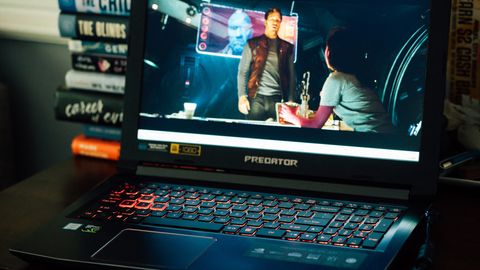TechRadar Verdict
Despite two glaring flaws, namely the cooling system and the speakers, this budget gaming laptop packs a punch. If you’re serious about gaming but have a limited budget, you’re going to want to pick this one up.
Pros
- +
Lots of power
- +
Affordable price
- +
144Hz refresh rate
- +
Decent battery life
Cons
- -
Gets too hot
- -
Loud fans
- -
Lackluster sound
Why you can trust TechRadar
The Acer Predator Helios 300 is, by all accounts, a budget gaming laptop. With that, there are a couple of blemishes about the device that are too obvious and too important to ignore, and there are some subtle corners cut as well. But, as is expected of many budget gaming laptops, cutbacks and compromises are expected. If you want the best, after all, you have to pay for the best.
That said, we are pleasantly impressed with this model’s performance for the price. This is a powerful machine for a budget gaming laptop. It can handle the most demanding games at medium to high settings. It has a refresh rate of 144Hz, which you’ll rarely see in gaming laptops of its kind. And it has a crisp, 1080p display with a true-to-life color palette.
- Buying Guide: 15 best laptops for most people in 2019
- Buying Guide: 10 best Gaming laptops 2019
Can you do better? If you have the money, definitely. But, if you’re a little strapped for cash, this is as good as you can get for for the price.

Here is the Acer Predator Helios 300 configuration sent to TechRadar for review:
CPU: 2.2GHz Intel Core i7-8750H (hexa-core, 9MB cache, up to 4.1GHz)
Graphics: Intel UHD Graphics 630; Nvidia GeForce GTX 1060 (6GB GDDR5)
RAM: 16GB DDR4 (2,666MHz)
Screen: 15.6-inch FHD (1,920 x 1,080) ComfyView IPS (144Hz refresh rate)
Storage: 256GB PCIe SSD
Ports: 1 x USB-C 3.1, 2 x USB 2.0, 1 x USB 3.0, HDMI 2.0, RJ-45 Ethernet, SD card reader, 3.5mm headphone jack
Connectivity: Intel 802.11ac Wi-Fi; Bluetooth
Camera: HD webcam (1,280 x 720) with 2 x mics
Weight: 5.95 pounds (2.7kg)
Size: 15.4 x 10.5 x 1.1 inches (39.1 x 26.7 x 2.8cm; W x D x H)
Price and availability
The basic configuration for Acer Predator Helios 300 in the US will only set you back $1,000, which features a 2.8GHz, quad-core Intel Core i7-7700HQ processor, an Nvidia GeForce GTX 1060 (6GB GDDR5) graphics card, 8GB of RAM and your choice of a 256GB solid state drive or 1TB hard drive.
This configuration is not available in the UK. The model there sets you back £1,000, has a less powerful processor and graphics card. This basic configuration in the UK has 2.5GHz, quad-core Intel Core i5-7300HQ processor and an Nvidia GeForce GTX 1050 Ti with 4GB of video memory, though it does boast both a 1TB hard drive and a 128GB solid state drive.
The top-of-the-line configuration in the US will set you back $1,500 with a 2.2GHz, hexa-core Intel Core i7-8750H processor, 16GB of RAM, a 1TB hard drive as well as a 128GB solid state drive, and the same graphic card as the basic configuration. The UK’s highest configuration boasts the same specs; however, the price is not available at the time of writing.
In Australia, on the other hand, only one configuration is available. It boasts the same specs as the US and the UK’s highest-end models, and costs AU$2,499.
Which configuration is best for you depends, of course, on your needs. The unit we tested, which matches specs of the highest configuration except for the 1TB hard drive, works well enough even with the most demanding games, and it’s $200 cheaper. However, you are limited to only about two or three installed AAA games with just the 256GB solid state drive; and paying $200 more for the ability to install more games is something to consider.







Design
We can’t find fault in the Acer Predator Helios 300’s design. It’s nothing amazing and hardly a stand-out, but it’s not poor either.
This gaming laptop does try to stick to the gamer aesthetic with its metal chassis in a gun-metal finish, black color with red accents, and geometric cuts and tapered edges. The Predator lettering and logo in silver adorn the top cover, while the bottom plastic cover has two, easy-to-remove compartments for the hard drive and the RAM, which you can upgrade.
We appreciate the number of available ports on this laptop, too. On top of two USB 2.0 ports and a headphone jack, it also boasts a USB 3.0 port, a USB 3.1 port, an HDMI port, Ethernet and an SD card reader, which definitely comes in handy if you’re using this for your amateur photography and such.
The laptop is mid-sized – definitely not small but also not too bulky, and surprisingly lighter than it looks. Although our review unit is missing a hard drive, and we wonder how much heavier it gets if there is one.
You might say that the design is an indication of how this gaming laptop is overall: it’s not the best and it has a couple of flaws, but it does well enough in other areas that you’ll find very little reason to complain.

Keyboard and touchpad
We actually like the keyboard on this gaming laptop. It’s not only comfortable, ergonomically speaking, with good enough bounce, sufficient travel, and a matte feel to keep your fingers from slipping; but it’s also responsive and accurate. Like the design, the keyboard doesn’t have any incredible features that stand out or give it a gaming edge.
That said, the Function shortcut keys manage things like turning the touchpad on and off, choosing different display options and adjusting volume – and at least the WASD keys are highlighted. However, it is as effective as all keyboards should be.
Our only complaint is that the bottom keys are taller than the others. We find that when we’re using the arrow keys for gaming, we often miss the ‘Up’ arrow key because the ‘Down’ arrow one is taller than we’re used to.
The touchpad is a slightly different story. Like with most gaming laptop touchpads, this one’s definitely not good for gaming, though it is responsive enough for productivity tasks. You’ll want a mouse if you want accuracy and responsiveness, like with most gaming laptops. The touchpad is also a little tight when you’re pressing down. Plus, we have run into the issue of it being non-responsive or erratic when we have a mouse installed. This issue usually fixes itself when we restart the laptop and disconnect the mouse.

Display, camera and sound
Here’s another example of the underlying theme in this gaming laptop. The camera could be better and the sound … let’s just say there’s definitely a lot of room for improvement. Yet the Full HD display is unexpectedly fantastic for a laptop of this kind. Let’s break these down.
We could do without the thick, 1-inch bezels. Other than that, we’re pretty happy with the 1080p display. It has true-to-life color reproduction, with stronger blue and magenta hues that we like better than warmer tones for gaming and watching movies. The display also boasts a 144Hz refresh rate, which you don’t typically see in budget gaming laptops. This is a major upgrade from the 2017 model to help minimize blur and make up for dropped frames.
The camera is just OK. The 720p resolution is noticeably grainy, but it’s good enough for making video calls and conferences.
Unfortunately, the set of speakers is one of the laptop’s two major flaws. Unfortunately, the speakers here are subpar at best. They have very little output on the low end and their high end is cut off, resulting in a sound that is dull, flat, muddled and hollow.
When you’re using the laptop for gaming, you probably won’t notice this poor audio – or, at the very least, get too bothered by it; and you always have the option to use headphones. However, if you’re watching movies or listening to music, audio will sound thin and lackluster, even after you make equalizer adjustments through the included Dolby Atmos software.
- 1
- 2
Current page: Introduction, price, design and display
Next Page Performance, battery life, features and verdict
Michelle Rae Uy is the former Computing Reviews and Buying Guides Editor at TechRadar. She's a Los Angeles-based tech, travel and lifestyle writer covering a wide range of topics, from computing to the latest in green commutes to the best hiking trails. She's an ambivert who enjoys communing with nature and traveling for months at a time just as much as watching movies and playing sim games at home. That also means that she has a lot more avenues to explore in terms of understanding how tech can improve the different aspects of our lives.

Nons SL660 review: an instant camera photographers will fall in love with

An incredible $100 billion bet to get rid of Nvidia dependence — tech experts reckon Microsoft will build a million-server strong data center that will primarily use critical inhouse components

The real total eclipse was better than the pics I shot with my iPhone 15 Pro Max and DSLR, and believe me I tried
